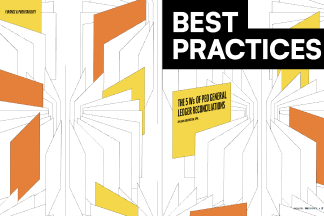

In today’s hyper-competitive business landscape, client experience (known as “CX” for short) has become the foundation of success across all industries, and PEOs are no exception. NAPEO’s PEO Industry Footprint 2023 (napeo.org/whitepapers) report indicates that at the end of 2022, 523 PEOs operated in the U.S. providing co-employment for at least 4.5 million worksite employees. With over 60% of those employees spread out across 99% of PEOs, the need for differentiation is greater than ever.
And when it comes to differentiating your PEO as a long-term partner for your clients and their teams, CX plays a non-negotiable role in your success – regardless of geography, size, or years in business.
WHY PEO CLIENT EXPERIENCE MATTERS
Think about a time you chose a product or service to help improve something in your life, only to find out it didn’t meet your expectations or was downright unpleasant. What happened next?
The best-case scenario is that you addressed the concern with the company, they took accountability, and the issue was resolved to your satisfaction (but the experience likely impacted your trust and confidence going forward). You may or may not have continued to work with them beyond that initial experience. Sometimes, though, an experience is so negative that not only do you terminate your relationship with an organization, but you also share about it within your network.
When it’s your business in question, your best protection against the scenarios above – and any in between – is an intentional, consistent focus on the experience you provide your current and future clients.
By prioritizing CX, PEOs can drive numerous benefits, including: increased growth, enhanced retention, improved reputation, and stronger employee engagement.
CX is about more than keeping clients happy; it’s about building a sustainable and thriving business.
ELEMENTS OF A WINNING PEO CLIENT EXPERIENCE
With so many PEOs to choose from (and countless other outsourcing options that overlap with typical PEO services) your business needs to embrace a proactive CX transformation. How you approach your PEO’s client experience is just as impactful as when or why.
Understanding the hierarchy of client needs is crucial for effectively tailoring your CX strategy. Each layer holds meaning on its own, but when built upon one another, these elements work in tandem to help you define and deliver a winning PEO experience.
1. Core Services: The essence of any successful PEO partnership is offering reliable core services such as payroll processing, benefits administration, and regulatory compliance. Clients expect these services to be delivered accurately and efficiently to relieve their burdens.
2. Communication and Transparency: Earning and maintaining your clients’ trust requires clear, consistent, and transparent communication. Clients need to feel informed and valued, and the way you communicate with them directly affects how much confidence they place in you.
3. Responsiveness and Accessibility: Clients who work with a PEO expect accessible, responsive service – after all, our ability to answer questions and provide support is why they hired you. If a client can’t reach you when they need you, or has to jump through hoops to do so, the value of your guidance becomes diminished; clients who trust you with their business want to know that you take it as seriously as they do.
4. Proactive Support and Guidance: Going beyond fulfilling basic needs, clients value PEOs who take the time to anticipate potential challenges, offer customized solutions, and provide valuable industry insights that are specific to each client’s business. This makes working with you feel easy and enjoyable.
5. Personalized Service and Relationship Building: Building genuine relationships with clients is key to differentiating your PEO and retaining your clients. A personalized approach helps people feel recognized and understood, not just as another account number.
By understanding and addressing these needs, PEOs can create a comprehensive CX strategy that fosters positive client experiences and ensures long-term success. So, how do you begin incorporating these elements into your own business operations?
CORE COMPONENTS OF A CX PROGRAM FOR YOUR PEO
For any CX program to be effective, it should be designed to fit the specific needs of a business and its clients. However, certain core components and best practices can increase your chances of developing – and maintaining – a successful transformation. Here are two of the most significant.
Vision, Values, and Goals: Every journey begins with the need to reach a destination. When it comes to your organization’s CX journey, your vision, values, and goals serve as this destination. What does the end result look/feel like? Which principles define how we operate and make decisions? How do we measure what “done” is?
Once your business has defined these answers, publish them. Revisit them often and engrain them in your culture. This ensures alignment across the organization and serves as a guiding principle for all CX initiatives.
Closed-Loop Feedback System: Once you understand where you’re going and what you hope to accomplish, it’s time to lay out how you’ll get there. And the truth is, CX transformation is a journey that requires you to stop and ask for directions along the way – often.
This is the purpose of establishing a closed-loop feedback system, which allows your clients and employees to consistently provide a pulse on their experience with the organization for your leadership to address. Simply put, the best way to learn how to improve something is by listening to the perspectives of those it is meant for. Soliciting feedback from your clients and staff can give you a direct view of how, and why, your PEO is delivering positive or negative experiences.
But it doesn’t stop at asking! For a feedback loop to be closed, your CX strategy must also provide a way for your company to share with clients what outcomes their input led to. If you aren’t committed to using feedback to drive improvements, it’s better not to ask at all.
With the growth and transformation the PEO industry itself has seen over the years, it’s clear that PEOs remain a valuable resource for small and medium-sized businesses. Leveraging some or all of these elements to elevate your client experience can help your PEO continue to elevate existing partnerships, earn new business, and thrive in a world of ever-evolving needs and expectations.
-
SHARE
- Copy to clipboard




